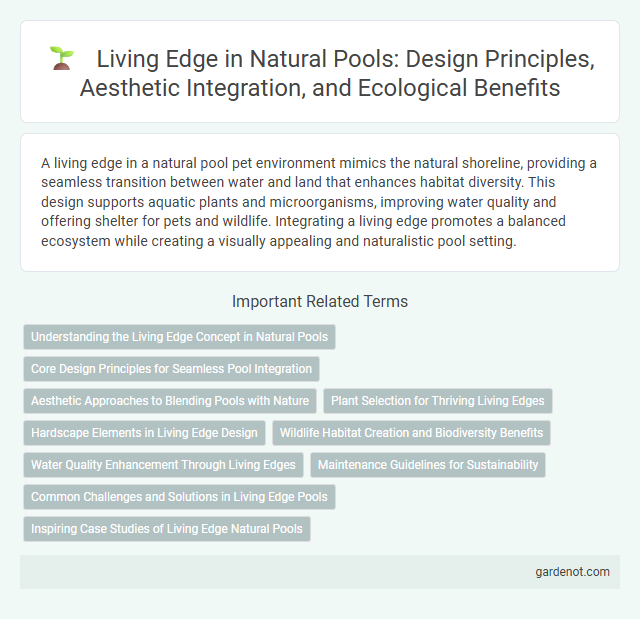A living edge in a natural pool pet environment mimics the natural shoreline, providing a seamless transition between water and land that enhances habitat diversity. This design supports aquatic plants and microorganisms, improving water quality and offering shelter for pets and wildlife. Integrating a living edge promotes a balanced ecosystem while creating a visually appealing and naturalistic pool setting.
Understanding the Living Edge Concept in Natural Pools
The Living Edge in natural pools refers to the transition zone where water meets planted areas, serving as a vital habitat for aquatic and terrestrial organisms. This edge plays a crucial role in water filtration, nutrient cycling, and provides shelter for beneficial wildlife, enhancing the pool's ecological balance. Integrating a well-designed Living Edge promotes biodiversity and maintains water clarity without relying on chemical treatments.
Core Design Principles for Seamless Pool Integration
Living edge design in natural pools emphasizes core principles such as ecological harmony, sustainable materials, and seamless blending with the surrounding landscape. The use of indigenous plants, gradual slopes, and natural filtration systems ensures water quality while promoting biodiversity. Prioritizing these elements creates an organic transition between pool and environment, enhancing aesthetic appeal and environmental sustainability.
Aesthetic Approaches to Blending Pools with Nature
Living edge designs in natural pools use irregular, organic lines to seamlessly integrate water features with surrounding landscapes. Incorporating native plants, natural stones, and gentle slopes enhances visual harmony while promoting ecological balance. This aesthetic approach emphasizes a fluid transition between pool and environment, fostering a tranquil, nature-inspired retreat.
Plant Selection for Thriving Living Edges
Selecting native aquatic and marginal plants such as water lilies, cattails, and pickerelweed is crucial for a thriving living edge in natural pools. These plants enhance water quality by filtering pollutants and provide habitat for beneficial insects and amphibians, promoting biodiversity. Proper plant density and zonation along the living edge support natural filtration, oxygenation, and aesthetic integration with the surrounding environment.
Hardscape Elements in Living Edge Design
Hardscape elements in Living Edge design blend natural stone, wood, and concrete to create seamless transitions between the pool and landscape. These components enhance functionality and aesthetics by providing walkways, seating areas, and retaining walls that complement the organic shapes of the natural pool. Integrating materials like flagstone or permeable pavers ensures durability while maintaining ecological harmony within the aquatic environment.
Wildlife Habitat Creation and Biodiversity Benefits
The living edge of a natural pool provides essential habitat for diverse wildlife, promoting ecosystem balance and supporting native plant and animal species. This zone enhances biodiversity by creating microhabitats for amphibians, insects, and aquatic plants, which contribute to natural water filtration and ecological sustainability. Integrating living edges in pool design fosters a thriving, self-sustaining environment that mimics natural aquatic ecosystems.
Water Quality Enhancement Through Living Edges
Living edges in natural pools serve as crucial biofilters, enhancing water quality by promoting beneficial microbial activity and nutrient uptake. These vegetated zones absorb excess nitrates and phosphates, preventing algae bloom and maintaining ecological balance. The integration of diverse aquatic plants in living edges supports natural filtration processes, ensuring clear, healthy water without chemical treatments.
Maintenance Guidelines for Sustainability
Living edge natural pools require careful maintenance to sustain their ecosystem balance and water clarity. Regular removal of debris and monitoring of aquatic plants prevent algae overgrowth and support biodiversity. Employing natural filtration systems like biofilters and maintaining appropriate water circulation are essential for long-term sustainability.
Common Challenges and Solutions in Living Edge Pools
Living edge pools often face challenges such as algae growth, sediment accumulation, and water circulation issues due to their natural filtration systems. Implementing biological filters, regular maintenance of aquatic plants, and ensuring proper water flow can effectively address these problems. Optimizing the balance between natural ecosystems and water quality is essential for maintaining a healthy living edge pool environment.
Inspiring Case Studies of Living Edge Natural Pools
Living Edge Natural Pools showcase innovative designs that harmonize with the environment, using biological filtration and native plants to maintain crystal-clear water without chemicals. Case studies highlight projects across diverse climates, such as European eco-resorts and North American private estates, where sustainable landscaping blends aesthetics with functionality. These examples demonstrate cutting-edge techniques in natural water purification, biodiversity enhancement, and energy-efficient maintenance, setting benchmarks in ecological swimming pool design.
Living edge Infographic

 gardenot.com
gardenot.com